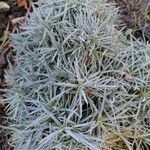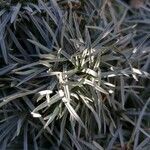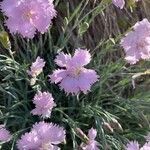Perennial, polymorphous cushion plant with a strong primary root. Plants with several sterile shoots at the base. Floriferous stems quadrangular, glabrous, with 4-5 inter-nodes above the basal rosette leaves, up to 35 cm. Leaves linear, stiff, erect, c. 1 mm broad, 3-nerved. Flowers fragrant, solitary or 2-3 together. Epicalyx scales mostly 4, about 1/4 as long as the calyx. Calyx 2-3 cm long, subcylindrical, green or slightly pur-ple, teeth narrowly elliptic to ovate, obtuse or acute, with scarious margin. Petals white, red or spotted, the lamina irregularly divided into 1/4-1/2, with narrow lobes, usually bearded.
Loosely multicipital perennial, 1–3 dm, glabrous and often glaucous; lvs linear, 2–8 cm × 1.5–3 mm, 3-nerved, the 2–8 pairs of cauline ones shorter than the basal; fls 1–5 on pedicels 1–3 cm; cal 15–30 mm, ca 40-nerved, the lobes 4–5 mm, pet-blade red to white, 12–18 mm, fringed-cleft to near the middle; fr surpassing the cal; 2n=30, 90. Native of Europe, occasionally escaped from cult. mainly in the n. part of our range. May–Aug.
A plant that keeps growing from year to year. It grows 40 cm high and spreads 50 cm wide. The stems are slender and have joints. The leaves are narrow and clasp the stem. They taper to the tip. The flowers are reddish-purple. They are white around the edges.






